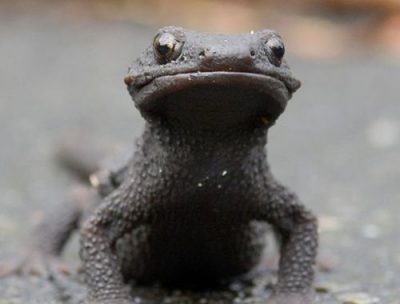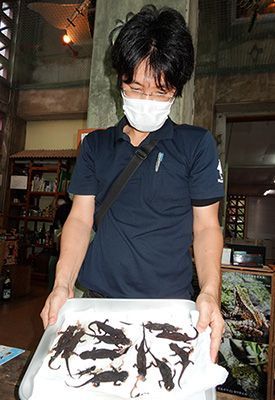Run over while looking for food? Large numbers of living fossils dead

Anderson’s crocodile newt (family Salimandriae), provided by the Nago Museum
April 23, 2020 Ryukyu Shimpo
Northern Okinawa – In Nago, there are many cases of Anderson’s crocodile newts becoming roadkill. The Anderson’s crocodile newt (family Salimandriae) is nicknamed “the living fossil,” and is a natural monument designated by Okinawa prefecture. The Nago Museum released the following statement: “Some people are visiting northern Okinawa by car in order to avoid the 3Cs and the novel coronavirus, but please be careful when driving on roads near rivers.”
From the night of April 20 to the morning of the 21st, twelve of the newts died on a forest road that goes up to the peak of Nago Mountain. This was confirmed by a member of the Friends of Nago Museum. The breeding season of the Anderson’s crocodile newt begins in late March and goes through April. It is thought the newts may have come into the road to eat worms and were then hit by passing cars.

The twelve Anderson’s crocodile newts thought to have been run over on a Nago Mountain forest road. (April 21, Nago Museum, Nago)
Naofumi Murata, curator of the Nago Museum, says, “these newts are largely extinct in the southern part of the island; they are a rare creature. If you see one, please lure it to the side of the road.” Hinako Miyazato says, “the Anderson’s crocodile newt species retains primitive characteristics and is designated as a national endangered species. I would like for every single one of us to be careful and reduce the number of newts that end up as roadkill.”
(English translation by T&CT and Ellen Huntley)
Previous Article:Orion to cease production of 9% alcohol by volume “Watta Strong” chuhai due to health concerns
Next Article:Nanbu Medical Center workers fighting COVID-19 post ‘thank you’ sign in windows
[Similar Articles]
- Okinawa Prefecture and the Ministry of the Environment patrol Yambaru forest to stop poaching
- An escaping crocodile captured at Chatan restaurant
- Habu-hunter Makishi opens a photo exhibit
- Rare butterfly spotted around planned site for US helipad in Takae
- In 7 months 17 rats of endangered species designated as natural monument accidentally killed
 Webcam(Kokusai Street)
Webcam(Kokusai Street)


